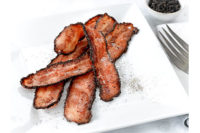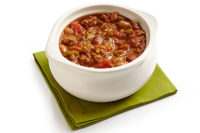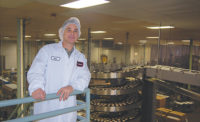2015 Bacon Report: No end to the love affair
Contrary to some published reports, Americans’ love for bacon is as strong as ever.



With three facilities dedicated to bacon production, SugarCreek Packing Co. can produce two billion fully cooked slices of bacon per year. Photo courtesy of SugarCreek Packing Co.

The annual Kansas City Bacon Fest draws thousands of bacon lovers and features creative bacon-themed entrees. Photos courtesy of the KC Bacon Fest.



As a co-manufacturer for other companies, SugarCreek has to be flexible to keep its customers satisfied. The company can produce bacon with a variety of cures, thicknesses and flavor profiles. Photo courtesy of SugarCreek Packing Co.







Earlier this year, Zagat published the results of its annual Dining Trends Survey. Ten thousand diners were quizzed on their dining habits, and as part of the survey, they gave opinions about various trendy foods, including kale, Brussels sprouts, beets and bacon. After tabulating the responses, Zagat declared that the bacon trend was waning — 34 percent of participants declared that they were “over it” with bacon, while only 28 percent loved it.
For the record, 45 percent loved Brussels sprouts and 38 percent loved beets.
If the bacon craze really is dying down, nobody has told the rest of the country. Bacon processors are reporting high demand, foodservice operators continue to find new ways to add it to entrees, and the price of pork bellies has made it the premium item on the entire hog carcass. There is plenty of love for bacon out there among consumers.
One way to gauge the popularity of bacon is to see how many people will come together to celebrate it.
“If you do a Google search for ‘baconfest,’ it is amazing how many communities throughout the U.S. have annual events centered around bacon,” says Carl Hermreck, vice president of pork pricing and pork sales for Cargill.
Cargill was a sponsor of the BaconTown Bacon & Brew Fest, held in August in Ottumwa, Iowa. Cargill’s pork processing facility is located in Ottumwa and produces more than 6 million pounds of pork daily and more than 1 billion pounds annually. The annual amount of bacon produced at that facility alone could wrap around the world more than 15 times. As part of the festival, Iowa Gov. Terry Branstad declared the city of Ottumwa the “Bacon Capital of Iowa” for a day.
Cargill (whose U.S. pork business JBS USA had agreed to acquire at presstime) has been involved with the festival for two years now, and it donates 50 pounds of bacon for each vendor to create distinctive bacon-themed dishes. Past creations have included caramel ice cream sundaes with bacon crumbles, bacon-wrapped egg rolls, candied bacon, bacon bourbon cupcakes, cheddar macaroni and cheese with bacon, and bacon-wrapped pineapple. Hermreck says they all sell out.
“It’s a celebration of bacon, which makes sense for Cargill because we recently invested in an expansion project that doubles our daily bacon production at Ottumwa,” Hermreck says.
In Missouri, the Kansas City Annual Bacon Fest just celebrated its seventh year. Starting with 250 attendees in its first year, it has grown to attract 2,500 bacon lovers, says Sarah Murphy, media coordinator. Proceeds for the event go to the Rehabilitation Institute of Kansas City, which provides medical rehabilitation and employment placement services for children and adults who have experienced a catastrophic injury or illness that resulted in a significant disability.
“Our Bacon-Fest is one of Kansas City’s greatest fundraisers,” Murphy says. “At our event, local restaurants will serve up samples of creative bacon fare while you enjoy a cold beer, unique bacon drinks and live music.”
Culinary highlights from past Bacon-Fests included caramelized Fuji apple chips with bacon syrup, bacon blue cheese and pecans from Ameristar Casino. Farmland Foods prepared six different types of bacon, and Paradise Locker Meats’ cooked a whole hog.
Also, for the record, a Google search for “Brussels sprouts festivals” located one such fest. In Australia.
The pork industry recovers
For much of the last two years, the Porcine Epidemic Diarrhea virus (PEDv) has been the talk of the pork industry, and it has driven hog prices since it first appeared in the United States in April 2013, says Dr. Ronald Plain, professor of agricultural economics and extension economist at the University of Missouri’s College of Agriculture, Food and Natural Resources.
“We had enormous death loss during the first year or so that we had the disease, and it gave us record high hog prices and short supply,” he says. “The second year, we’ve been much better at keeping death losses to the PED virus down, so we’ve got a lot more hogs this year, a lot more pork and lower prices.”
After experiencing the losses of the first year, hog producers tried to breed more sows to anticipate a high death toll, but that loss never materialized. Plain notes this year’s hog slaughter numbers are likely going to be the second highest ever, behind 2008.
Even with a higher pork supply, pork belly prices are soaring. After reaching a five-year low in April, prices of bellies have steadily increased, reaching $1.6968 a pound in early August, Bloomberg News reports. Demand has helped drive those high prices.
When it comes to innovation, the report noted some of the recent ways bacon is being utilized in the foodservice world — Bacon-Wrapped Crust Pizza from Little Caesars, Orange Chicken with Bacon from Panda Express, Triple Bacon Sirloin from LongHorn Steakhouse. The Chicago White Sox added bacon on a stick to its menu at U.S. Cellular Field this season.
“The trend in bacon continues to drive innovation and growth, and there’s no end in sight. Fans of the smoky, salty protein just can’t get enough,” Technomic reports.
Companies that specialize in bacon are reporting that orders keep coming in. Cargill has its own branded bacon products, including Sterling Silver and the all-natural, nitrate-free Good Nature lines. The bulk of the company’s bacon is produced under its customers’ own brands, Hermreck says, and those products are produced to exacting specifications.
“If a customer wants a thick-cut, applewood-smoked bacon, that’s what we’ll produce for them,” he says. “It’s all about meeting our customers’ needs and helping them to be successful. That’s not difficult when it comes to bacon, because we know bacon makes everything better.”
As noted by Cargill’s plant expansion at its bacon plant in Ottumwa, the company is not hurting for customers. Regardless of what foodie blogs or surveys may say, the consumer’s love for bacon remains strong.
“We see that in the form of requests from our customers, in addition to the vast array of recipes and uses we’re seeing for bacon,” Hermreck says. “It’s versatile, and it complements many other flavors, while also being able to stand on its own attributes.”
SugarCreek, a manufacturer of numerous types of products, has three plants in Ohio and Kansas that produce raw and fully cooked bacon as well as bacon bits. Chief Operations Officer Michael Richardson says that the company can produce about 2 billion fully cooked slices per year.
“We’re running all of our plants as much as we can. The requests have not died down, so [bacon] is still very much on trend,” he says.
SugarCreek’s roots are in the bacon business, but the company’s strong growth has allowed it to expand, both in terms of products it makes and in locations. It is opening two new facilities in 2015 to help expand its abilities, including its sous vide cooking process.
As a co-manufacturer for private label customers and branded products, SugarCreek has to be adept at meeting all of its customers’ requirements. When it comes to bacon, the company can provide different cures, flavors, slice thicknesses and packaging options. Richardson says the company has hundreds of SKUs dedicated to bacon products.
According to Richardson, bold and spicy flavors such as jalapeno bacon continue to grow. When it comes to slice size, consumers say thicker is better.
“Consumers may feel a little cheated on the slice if it’s not a thick slice,” he says.
Bacon labels are becoming cleaner, as SugarCreek has produced more and more antibiotic-free bacon with natural cures. That trend is growing not only at the retail level but also in foodservice, where even quick-service restaurants are looking to market their proteins as antibiotic-free and natural.
The bacon bit business is a sizable market for SugarCreek. Starting from bacon ends and pieces, the company can customize the bits to the application.
“There is a lot of nuance to it,” Richardson says of the process. “We have different methods of how it can be cooked, diced, spun or ground. We would handle a bacon bit tailored to a salad differently than a bacon piece targeted to go onto a pizza. We do them every which way, from fine, almost bacon dust to bigger toppings.”
Bacon jerky has become a popular product as well. Richardson says its bacon jerky is sliced thick and then cooked low and slow. The resulting product has generated a tremendous response from customers and has helped give bacon a strong foothold in the growing meat snacks market.
SugarCreek has used in technology to help improve yield and throughput. Richardson points to advancements in slicing and oil bath cooking as investments that have enabled the company to keep costs down and stay competitive.
A consistent supply and consistent quality of pork bellies is one area that could help improve the bacon market, Richardson notes. As hog weights have gone up, so has the fat content in the bellies.
“We don’t find that the higher fat content performs as well in some of our cooking operations,” he says. “While it may be great for the further consumer from a flavor standpoint, there is a cost impact to that.”
SugarCreek used pork belly scanning equipment in its bacon plants, which grades and measures every belly. The company uses the data to make better choices as an operations group and to work better with its packing partners.
“Raw material makes up 70-plus percent of your cost, so any consistency you can bring to that brings results to the bottom line,” he adds. NP
Looking for a reprint of this article?
From high-res PDFs to custom plaques, order your copy today!













